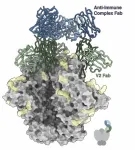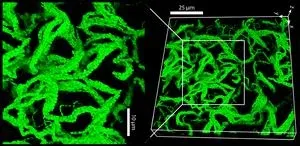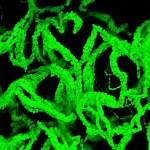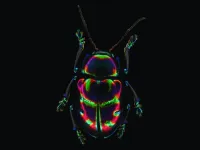(Press-News.org) LA JOLLA, CA—Many vaccines work by introducing a protein to the body that resembles part of a virus. Ideally, the immune system will produce long-lasting antibodies recognizing that specific virus, thereby providing protection.
But Scripps Research scientists have now discovered that for some HIV vaccines, something else happens: after a few immunizations the immune system begins to produce antibodies against immune complexes already bound to the viral protein alone. They don’t yet know whether this chain reaction, described in Science Immunology, hurts or helps the immune system’s ability to fight HIV, but say that understanding it better could lead to improvements in HIV vaccines. The research was published in the journal on January 17, 2025.
“These anti-immune complex antibodies have not been studied in very much depth, especially in the context of HIV vaccination,” says Andrew Ward, PhD, professor of Integrative Structural and Computational Biology at Scripps Research and senior author of the new paper. “Understanding these responses could lead to smarter vaccine designs and Immunotherapeutics. It’s an exciting step forward in fine-tuning antibody and vaccine-based strategies against HIV and other diseases.”
The new observation came about when Ward’s team was using advanced imaging tools to study how antibodies evolve after multiple HIV vaccine doses. A technique invented by the lab, known as Electron Microscopy-Based Polyclonal Epitope Mapping (EMPEM), lets the researchers see exactly where on the HIV virus antibodies bind. When they carried out the experiments on blood from animals that had received multiple doses of an experimental HIV vaccine, they discovered something surprising: some of the antibodies were not binding directly to the HIV viral antigen, but to immune molecules on its surface.
“These antibodies actually make no direct contact with the viral protein,” says Sharidan Brown, a graduate student at Scripps Research and first author of the new paper. “We are the first to structurally characterize this kind of antibody in the context of HIV vaccination.”
Scientists have previously known that anti-immune complex antibodies could form in some situations. This happens when the immune system recognizes antibodies already bound to viral proteins. An additional immune response occurs, spurring the production of new antibodies, including some that bind to existing immune complexes on the virus’ surface.
In a series of follow-up experiments on HIV-vaccinated animals, Brown, Ward, and their colleagues showed that these kinds of anti-immune complex antibodies often emerge between the second and third administrations of a vaccine.
“We showed that these antibodies exist but what we don’t yet know is how they shape the immune response,” says Brown. “They could be detrimental because they are not directly neutralizing the virus, but they could lead to larger immune complexes which actually spur more activity against the viruses and infected cells in ways that we don’t fully understand.”
If future experiments show that that the antibodies are, indeed, unwanted, it could guide vaccine design strategies to minimize the immune complex response and improve the ability for vaccines to directly neutralize HIV. It also could lead to changes in HIV vaccine schedules, potentially including a series of different boosting immunizations against the virus rather than multiple doses of the same vaccine.
“Minor changes between each dose could create just enough diversity that you don’t produce antibodies against antibodies,” says Brown.
The research team is planning to continue studying the antibodies, as well as whether similar antibody responses are produced after multiple doses of other vaccines or during natural infection.
In addition to Ward and Brown, authors of the study, “Anti-Immune Complex Antibodies are Elicited During Repeated Immunization with HIV Env Immunogens,” include Leigh Sewall, Daniel Montiel Garcia, and Philip Brouwer of Scripps Research; Aleksandar Antanasijevic of École Polytechnique Fédérale de Lausanne; and Rogier Sanders of University of Amsterdam.
This work was supported by funding from Scripps Research, an amfAR Mathilde Krim Fellowship in Biomedical Research (110182-69-RKVA), the National Institute of Allergy and Infectious Diseases (R01 AI136621, P01 AI110657, UM1 AI100663), the Bill and Melinda Gates Foundation, and the Collaboration for AIDS Vaccine Discovery (CAVD) Network (INV-002916).
About Scripps Research
Scripps Research is an independent, nonprofit biomedical institute ranked one of the most influential in the world for its impact on innovation by Nature Index. We are advancing human health through profound discoveries that address pressing medical concerns around the globe. Our drug discovery and development division, Calibr-Skaggs, works hand-in-hand with scientists across disciplines to bring new medicines to patients as quickly and efficiently as possible, while teams at Scripps Research Translational Institute harness genomics, digital medicine and cutting-edge informatics to understand individual health and render more effective healthcare. Scripps Research also trains the next generation of leading scientists at our Skaggs Graduate School, consistently named among the top 10 US programs for chemistry and biological sciences. Learn more at www.scripps.edu.
END
A chain reaction: HIV vaccines can lead to antibodies against antibodies
Scripps Research scientists discovered that repetitive HIV vaccinations can lead the body to produce antibodies targeting the immune complexes already bound to the virus—knowledge that could lead to better vaccines.
2025-01-17
ELSE PRESS RELEASES FROM THIS DATE:
Bacteria in polymers form cables that grow into living gels
2025-01-17
Scientists at Caltech and Princeton University have discovered that bacterial cells growing in a solution of polymers, such as mucus, form long cables that buckle and twist on each other, building a kind of "living Jell-O."
The finding could be particularly important to the study and treatment of diseases such as cystic fibrosis, in which the mucus that lines the lungs becomes more concentrated, often causing bacterial infections that take hold in that mucus to become life threatening. This discovery ...
Rotavirus protein NSP4 manipulates gastrointestinal disease severity
2025-01-17
Researchers at Baylor College of Medicine and collaborating institutions have improved our understanding of how rotavirus, the most common cause of acute gastroenteritis in children, makes people sick. The study published in Science Advances is among the first to show that the rotavirus protein NSP4 is both necessary and sufficient for multiple aspects of rotavirus infection by disrupting calcium signaling not only within infected cells but also in nearby uninfected cells. These disruptions in calcium signaling affect rotavirus disease severity, providing new insights into how ...
‘Ding-dong:’ A study finds specific neurons with an immune doorbell
2025-01-17
Interleukin-1 (IL-1) is a key molecule involved in inflammation and plays an important role in both healthy and diseased states. In disease, high levels of IL-1 in the brain are linked to neuroinflammation, which can disrupt the body’s stress response, cause sickness-like behaviors, worsen inflammation by activating brain immune cells, and allow immune cells from the body to enter the brain. It also can lead to brain damage by causing support cells to produce harmful molecules. Elevated IL-1 levels are associated with mood disorders, ...
A major advance in biology combines DNA and RNA and could revolutionize cancer treatments
2025-01-17
Our genes contain all the instructions our body needs to function, but their expression must be finely regulated to guarantee that each cell performs its role optimally. This is where DNA and RNA epigenetics comes in: a series of mechanisms that act as "markers" on genes, to control their activity without modifying the DNA or RNA sequence itself.
Until now, DNA and RNA epigenetics were studied as independent systems. These two mechanisms seemed to function separately, each playing its own role in distinct stages of the gene regulation process.
Perhaps that was a mistake.
In a publication ...
Neutrophil elastase as a predictor of delivery in pregnant women with preterm labor
2025-01-17
Background and objectives
No previous study has been conducted in Nigeria on the role of neutrophil elastase in predicting preterm birth. The present study aimed to determine the role of the neutrophil elastase test in predicting birth in women with preterm labor.
Methods
The present prospective cohort study recruited 83 pregnant women with preterm labor between 28 and 36+6 weeks of gestation, and followed up these subjects for 14 days. The controls comprised 85 pregnant women without preterm labor. The cervicovaginal fluid was collected and tested using the neutrophil elastase test. Then, the sensitivity, specificity, and positive and negative predictive parameters were determined. ...
NIH to lead implementation of National Plan to End Parkinson’s Act
2025-01-17
WHAT:
With support from the U.S. Department of Health and Human Services (HHS) Office of the Assistant Secretary for Health (OASH), the National Institutes of Health (NIH) is leading the implementation of the Dr. Emmanuel Bilirakis and Honorable Jennifer Wexton National Plan to End Parkinson’s Act (P.L. 118-66), which was signed into law on July 2, 2024. This follows a delegation of authority from the Secretary of the Department of Health and Human Services to the NIH Director.
The act establishes a Federal ...
Growth of private equity and hospital consolidation in primary care and price implications
2025-01-17
About The Study: In this cross-sectional study, nearly one-half of all primary care physicians (PCPs) were affiliated with hospitals, while private equity-affiliated PCPs were growing and concentrated in certain regional markets. Relative to PCPs in independent settings, hospital-affiliated PCPs and private equity-affiliated PCPs had higher prices for the same services.
Corresponding Author: To contact the corresponding author, Yashaswini Singh, PhD, MPA, email yashaswini_singh@brown.edu.
To access the embargoed study: Visit our For The Media website at this link https://media.jamanetwork.com/
(doi:10.1001/jamahealthforum.2024.4935)
Editor’s ...
Online advertising of compounded glucagon-like peptide-1 receptor agonists
2025-01-17
About The Study: This cross-sectional study showed websites that sell compounded glucagon-like peptide-1 receptor agonists (GLP-1 RAs) often partially informed and sometimes misinformed potential consumers. Compounded medications contain the same active ingredients as in branded medications but may contain different inactive ingredients. Most websites did not disclose that compounded GLP-1 RAs were not FDA approved, although some suggested these drugs were FDA approved. Many websites provided limited safety information and unauthorized efficacy claims. Some ...
Health care utilization and costs for older adults aging into Medicare after the affordable care act
2025-01-17
About The Study: This study found modest evidence of reductions in out-of-pocket costs and improvements in health among adults entering Medicare after the Affordable Care Act. Insurance coverage and financial assistance should be preserved and enhanced to improve health and health care access among vulnerable older adults.
Corresponding Author: To contact the corresponding author, Renuka Tipirneni, MD, MSc, email rtipirne@med.umich.edu.
To access the embargoed study: Visit our For The Media website at this link https://media.jamanetwork.com/
(doi:10.1001/jamahealthforum.2024.5025)
Editor’s ...
Reading the genome and understanding evolution: Symbioses and gene transfer in leaf beetles
2025-01-17
With more than 50,000 described species, the leaf beetle family is distributed worldwide and represents about a quarter of the species diversity of all herbivores. Leaf beetles can be found to feed on almost all plant groups. They live in the rhizosphere, the canopy and even underwater. Many leaf beetles, such as the Colorado potato beetle, are notorious pests. Their species richness and global distribution highlight their evolutionary success, which is particularly astonishing given that leaves are a difficult food source to digest and provide unbalanced nutrients.
Researchers from the Department of Insect Symbiosis at the Max Planck Institute for Chemical ...
LAST 30 PRESS RELEASES:
Numbers in our sights affect how we perceive space
SIMJ announces global collaborative book project in commemoration of its 75th anniversary
Air pollution exposure and birth weight
Obstructive sleep apnea risk and mental health conditions among older adults
How talking slows eye movements behind the wheel
The Ceramic Society of Japan’s Oxoate Ceramics Research Association launches new international book project
Heart-brain connection: international study reveals the role of the vagus nerve in keeping the heart young
Researchers identify Rb1 as a predictive biomarker for a new therapeutic strategy in some breast cancers
Survey reveals ethical gaps slowing AI adoption in pediatric surgery
Stimulant ADHD medications work differently than thought
AI overestimates how smart people are, according to HSE economists
HSE researchers create genome-wide map of quadruplexes
Scientists boost cell "powerhouses" to burn more calories
Automatic label checking: The missing step in making reliable medical AI
Low daily alcohol intake linked to 50% heightened mouth cancer risk in India
American Meteorological Society announces Rick Spinrad as 2026 President-Elect
Biomass-based carbon capture spotlighted in newly released global climate webinar recording
Illuminating invisible nano pollutants: advanced bioimaging tracks the full journey of emerging nanoscale contaminants in living systems
How does age affect recovery from spinal cord injury?
Novel AI tool offers prognosis for patients with head and neck cancer
Fathers’ microplastic exposure tied to their children’s metabolic problems
Research validates laboratory model for studying high-grade serous ovarian cancer
SIR 2026 delivers transformative breakthroughs in minimally invasive medicine to improve patient care
Stem Cell Reports most downloaded papers of 2025 highlight the breadth and impact of stem cell research
Oxford-led study estimates NHS spends around 3% of its primary and secondary care budget on the health impacts of heat and cold in England
A researcher’s long quest leads to a smart composite breakthrough
Urban wild bees act as “microbial sensors” of city health.
New study finds where you live affects recovery after a hip fracture
Forecasting the impact of fully automated vehicle adoption on US road traffic injuries
Alcohol-related hospitalizations from 2016 to 2022
[Press-News.org] A chain reaction: HIV vaccines can lead to antibodies against antibodiesScripps Research scientists discovered that repetitive HIV vaccinations can lead the body to produce antibodies targeting the immune complexes already bound to the virus—knowledge that could lead to better vaccines.




